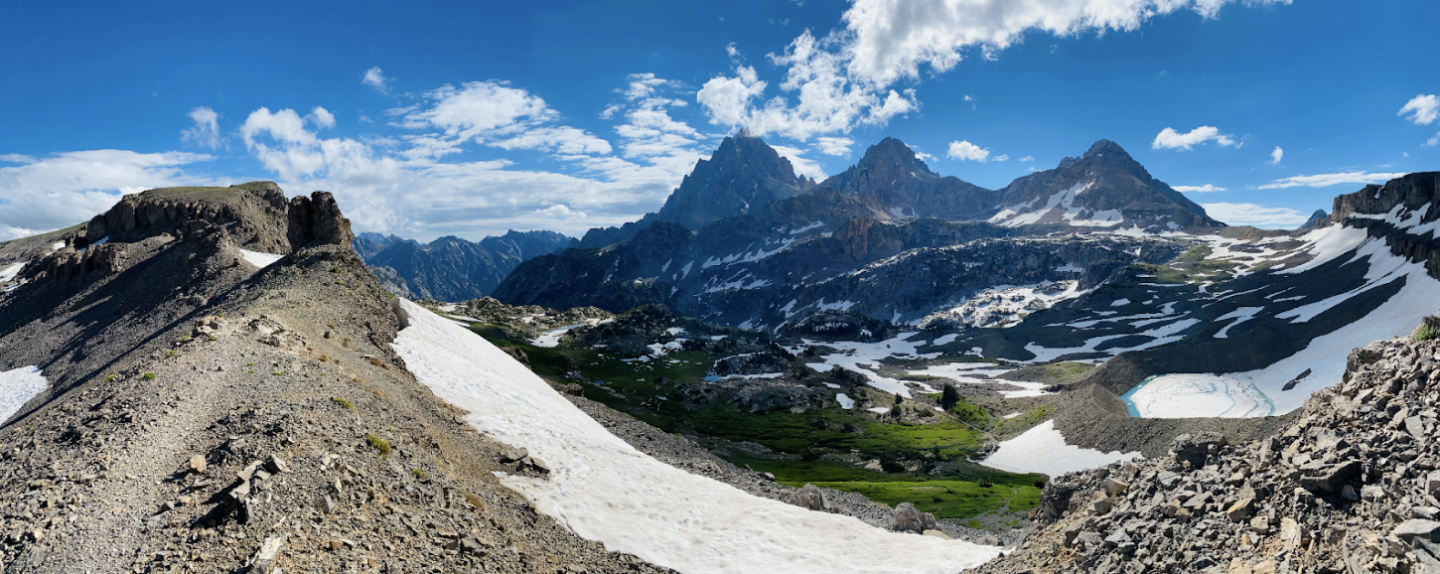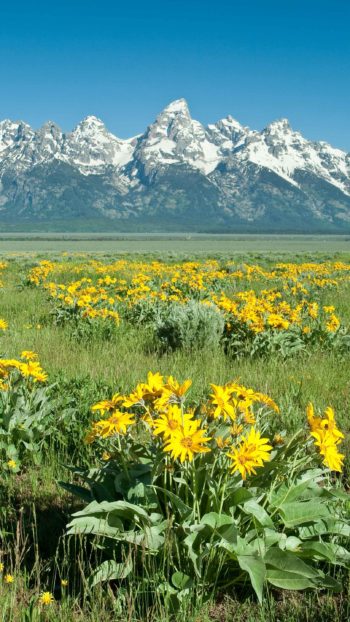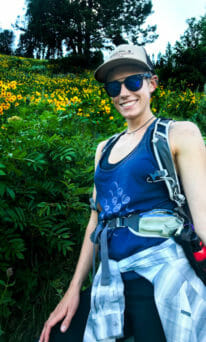Hiking Grand Teton
One of my favorite pastimes is trekking up into the high alpine habitat of the Teton Mountain Range. Starting at the valley floor where sagebrush carpets the landscape, which, as I ascend the trail, will transition into pale aspen groves, then old-growth pine forests with towering spruces and robust Douglas Firs that could be hundreds of years of age. At about 9,000ft in elevation, the trail will break free of the tree line, and I’ll push on through open highland meadows laden with flowers and stunted White Bark pines. I might even continue towards those high-elevation peaks, where the slopes are scattered with rocky talus and sun-cupped snowfields. Here the views are assuredly vast, mind-blowing, and hugely rewarding, no matter how much my aching legs, blistered feet, and burning lungs might disagree.
Quite often, I make these ventures into the mountains on my own. I love nothing more than hearing the grind of my footsteps on a trail, with only the singing birds and the peaceful sound of the wind through the trees to accompany me. This is why I can’t entirely agree with the sentiment when the precautionary mentality of “don’t go alone” becomes prevalent. Solitude amongst nature is a precious resource that people should not be turned away from; instead, they should be versed on how to enjoy it more carefully.
The dangers of hiking in places like Grand Teton National Park or the surrounding Bridger-Teton National Forest are immense. If you want to explore such terrain, it is wise to have a hiking buddy. However, not everyone always has a friend to go with. Perhaps you are new to the area, haven’t met a hiking buddy yet, or are just visiting with only a few days to spare. Even those who’ve lived in Jackson for years know most jobs require extended work hours, and with everyone’s different schedules, it is extremely difficult to coordinate group activities. When the free time does arise, most would rather catch up on rest or do chores at home. I happen to be one of the crazy ones who would rather hike up a mountain… than try to cram in doing my laundry and washing the dishes at the end of the day.
Experienced or not, I do not think you should let the risks of hiking alone deter you from going out into a landscape begging for exploration. There are just safer ways to do it!
Communication
A great place to start is to tell someone where you plan to go and what trails you will be hiking. This could be a friend, coworker, or family back in a distant hometown. Inform them of what trailhead you will park at, what you are driving, and how long you plan on being out; perhaps share your planned route on a map, and it could even be a good idea to describe what you will be wearing on the hike. Make sure those you are sharing this information with know some essential phone numbers in the case of an emergency:
- Teton County Search and Rescue: (307) 732-8337
- Teton County Sheriff’s Office Communication Center: (307) 733-2331
Communicating such details could seriously aid Search and Rescue in locating you in the extreme event that you go missing. This could be because you twisted an ankle on the trail and are slowly making your way out of the backcountry or a more dire scenario in which you got lost on the course and cannot find your way back.
Boundaries
As mesmerizing as Grand Teton National Park is, do not let that tempt you into thinking you could scale the 13,775ft Grand Teton in a day if mountaineering isn’t part of your skill set. Knowing your boundaries is an excellent way to avoid an emergency when hiking alone!
Have you never hiked solo before? Perhaps find a popular trail where people will consistently be passing by. Have you never hiked at high altitudes before? Consider a trail lower in the valley where the terrain is more level. Want to start practicing hiking in mountainous terrain? Begin with trails that take you into the high alpine areas but do not require rock climbing or extensive route-finding skills—worried about weak knees and ankles on steep terrain? Take trekking poles or a walking stick to help you stabilize yourself! The answer does not have to be “STAY HOME” if you are new to venturing out on your own in the Tetons, but research is everything, so you know what to expect and can be prepared to keep the trip within your boundaries.
The Grand Teton Backcountry Office can help you plan a hike best suited to your skills and comfort level. You can speak with them directly at the Craig Thomas Visitor Center in Moose, WY, or call (307) 739-3309.
Navigation
While you might often use your phone for navigation on roadways, most trails lack phone service, so that device is reduced to being not much more than a camera. However, apps (such as AllTrails and Google Maps) allow you to download maps and trail routes that can be used even when your phone is in airplane mode. I prefer having a physical map (USGS Topographic maps are a great resource) on me when making a solo trek into new areas, but I almost always download the trail information to my phone. I love keeping track of my progress, so I know how far I’ve gone and how much farther I have left. This can also help you pace yourself on longer hikes, so you do not push yourself to exhaustion before heading back.
A disclaimer from a frequent hiker if you are getting into the activity- the last mile of the hike is often the toughest. By that point, you are tired, eager to get back to the trailhead, and, if you’re like me, starting to fantasize about what food you’ll eat afterward. Once my mind wanders, is the exact point a rock will grab my foot or a branch catches a shoelace, and I wind up on the ground? So daydream with caution!
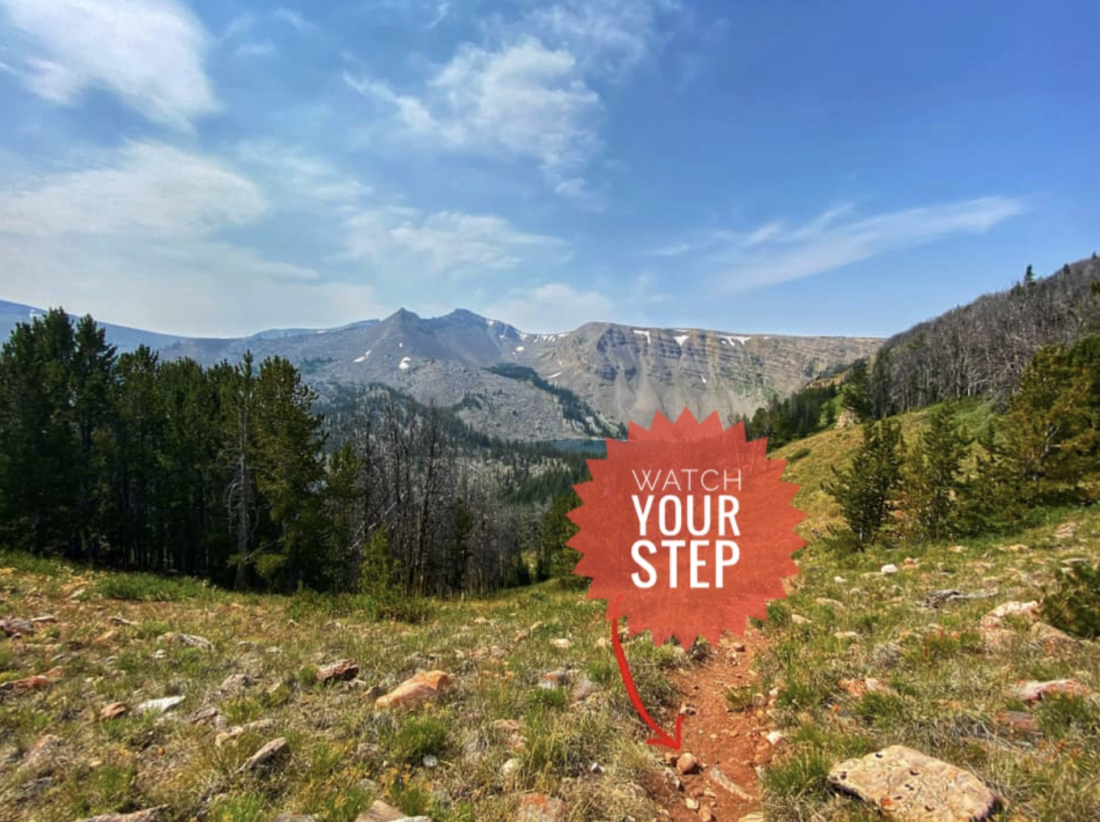
Essentials
If you’ve hiked around the Tetons before, you should already know what to bring, but if you’re just getting started, here are some tools and resources you’ll need:
- Water! This is obvious, but maybe you don’t know how much. I always have at least 32oz with me, but if I’m hiking more than 8 miles on a strenuous trail, I’ll take as much as 64oz. Higher altitudes make it easier to dehydrate, and even the mountains can succumb to the summer heat, increasing the risk of Heat Exhaustion or Heat Stroke.
- Bear Spray is something I never forget when I hike anywhere, there could be bears, moose, elk, people… If you’re unfamiliar with it, this is a canister of concentrated capsaicin (what makes cayenne peppers spicy) spray that affects anything with the eyes and nose. It works on bears, and from what I’ve heard is not much fun for humans either. It’s tough to get the opportunity to practice using bear spray, but know that it will spray 30 feet and disperse into a large cloud. This is meant to be a barrier between you and an animal charging at you. Once the animal hits that capsaicin cloud, the last thing it should worry about is following through on the attack. If it’s a windy day, pay close attention to what direction those gusts are going.
- On most day hikes, I’ll carry my 25-liter pack, which is a perfect size to fit multiple items. Remember that hiking packs typically have a strap that clips around your waist to redistribute weight, so it is not digging into the shoulder straps.
- Layers, layers, layers… this might be a somewhat redundant piece of information since pretty much every outdoor resource will recommend it. This is about preparing for the unexpected; even in summer, it could abruptly start raining or snowing in mountain country. I always pack a waterproof and insulating jacket, which I’ve even had to throw on when a simple cloud blocks the sun for 15 minutes because that can result in a 10-degree Fahrenheit temperature drop. I’ll also wear a tank top with a light cotton or synthetic long-sleeved shirt over it, which can act as lightweight insulation and protection from UV rays. A hat is also a good idea; this could be a baseball cap or, as I prefer, a wide-brimmed hat for maximum coverage.
- Thinking about those UV rays, always pack sunscreen! I go for the strong stuff, 50-70 spf with water resistance for added insurance from sweating. Or perhaps insurance from taking an unexpected dunk in a creek as I was trying to cross it.
- I always bring a small waterproof bag with me, one that can primarily fit my phone. I can preemptively stick my phone in that pouch to keep it from getting water damage, which is especially important if you happen to be using your phone for navigation purposes. In case of rain or going back to the creek…
- Trekking poles or a walking stick is something to consider if you haven’t had much practice traversing loose talus slopes, snowfields… or creeks with slippery rock bottoms. That extra source of stability can be a lifesaver or even a knee-saver if you’re going down a steep trail for multiple miles.
- Bring what makes you feel most comfortable and secure. A simple first aid kit is always a good idea to bring. This could be a collection of band-aids or an extensive setup with bandages, braces, scissors, alcohol wipes, etc. Unless I go on a multi-day backcountry adventure, I will only bring band-aids to cover a scratch or blister and medical tape if I twist an ankle and need to make a splint.
- How much you enjoy a hike can all depend on your type of boots. The last thing you want is to be struggling for miles down a trail in footwear that is either painful or not equipped for the terrain. The aggressive tread is vital in stabilizing yourself on trails with loose soil and stones, along with a sole thick enough that rocks will not dig into the bottom of your foot. My hiking boots are usually a half size bigger than my actual shoe size, which helps keep my toes from getting too smashed when going down a steep trail. A slightly bigger boot can also help accommodate any swelling your feet might experience while hiking.
Caution
Learn to recognize what is dangerous. Playing outside is fun but holds great potential for injury if you are unaware of the risks. It’s not that everything outdoors wants to hurt you; it’s just that everything COULD hurt you.
- Wildlife. Many large wildlife species in Grand Teton National Park could be encountered on the trail. I’ve personally encountered and been chased by multiple agitated moose, and I’ve seen Grizzly Bear tracks on a trail before but, fortunately, have yet to meet one while hiking. I handle this risk by constantly looking for fresh tracks, feces, and signs to know what has been in the area. I’ll even put my nose to work since species like Moose and Elk often have a strong musky odor. I still need to learn the smell of a Grizzly, though! Some people carry a “bear bell” with them to alert wildlife down the trail of their approach since many attacks happen due to an animal being surprised. In contrast, I prefer to listen for what wildlife might be ahead; I find the sound of the bell to cover up potential grunts, huffs, rustling bushes, or breaking twigs that might instead alert me to the approach of an animal.
- Terrain. The sheer variety of habitats seen on one trail in the Teton Mountain range is incredible. In just 4-5 miles, the scenery can transition from dense forest to open meadow, to a boulder field, to a sheer vertical rock wall, or the sheer drop off a cliff. In wooded areas, trees will often fall across the trail, some being small enough to hop over and others being large enough that you could injure yourself trying to climb over. In those cases, I’ll usually walk around if possible. Boulder fields can be fun to navigate by channeling your inner Mountain Goat! But these boulders always have the potential to shift and roll down a slope, so to reduce the risk of injury, I will find the route with the least amount of pitch and areas with rocks smaller than my body size. Steep snowfields and talus slopes both present sliding risks; I will avoid both as much as possible and seek out a route on more level ground, so I do not take the fast way down into the bottom of a canyon.
- Weather. I am never completely opposed to hiking in the rain or snow. Usually, that means no one else is on the trail, so I’ll find that solitude I’m always seeking. However, I will not head for the high country when there is any chance of precipitation. While the valley might get a few inches of snow or rain, the mountains above 9,000 ft might rapidly receive multiple feet! The trail can quickly be buried and obscured in snowfall, making it easy to get lost and increasing the chance of getting hypothermia. Lightening is also a hazard, especially when exposed on a treeless rocky knob in the Tetons. Especially in summer, mid-afternoon storms can come quickly rolling in. This is why I start my hikes into the high alpine as early as possible, so I am heading back into lower elevations by the time weather starts building up over those tall granite ridgelines.
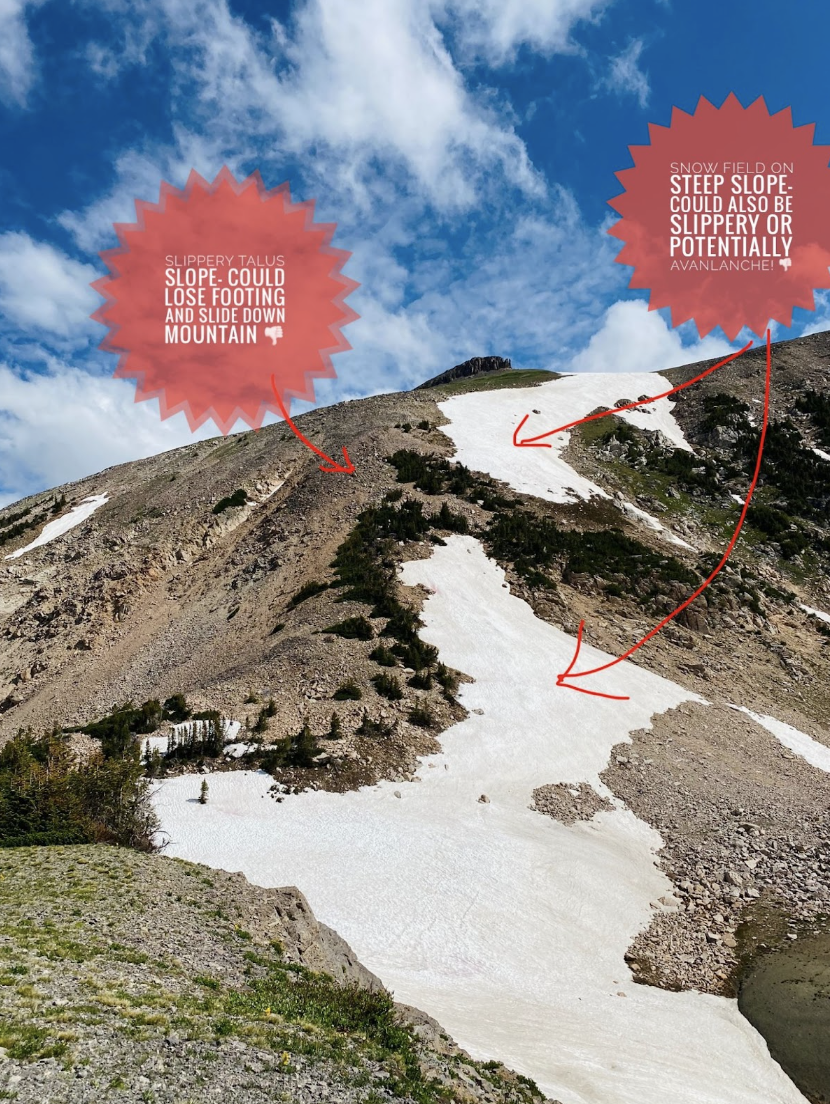
Always remember that if you are afraid, do not hesitate to turn back. If anything, trust your instincts when they tell you, “I should not do that,” especially when hiking alone. I’ve encountered a multitude of potentially risky situations when hiking on my own, but I never push myself to the point I am debilitated by fear and anxiety. Instead, I work to maintain a functional awareness, so I’m regularly assessing the terrain and noting where the dangers are and how I can carefully negotiate them.
Consider these essential things if you plan to try a solo hike. Being alone does not have to mean everything is more dangerous inherently. Just telling someone where you are going, staying aware, and being prepared will help you enjoy safer and more careful solitude.


